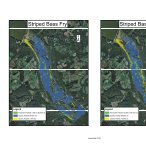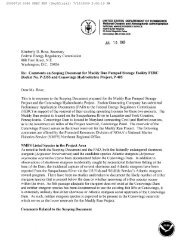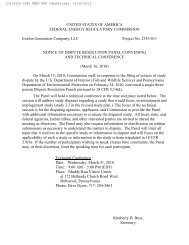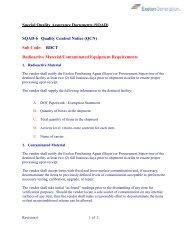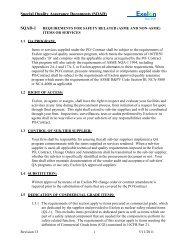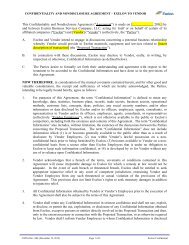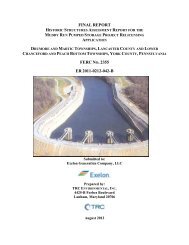FEDERAL ENERGY REGULATORY COMMISSION Project No. 405 ...
FEDERAL ENERGY REGULATORY COMMISSION Project No. 405 ...
FEDERAL ENERGY REGULATORY COMMISSION Project No. 405 ...
You also want an ePaper? Increase the reach of your titles
YUMPU automatically turns print PDFs into web optimized ePapers that Google loves.
20100204-3055 FERC PDF (Unofficial) 02/04/2010<br />
<strong>Project</strong> <strong>No</strong>. <strong>405</strong>-087 16<br />
license term (30 to 50 years) and highlight the effect on the cumulatively affected<br />
resources. The study report should include a sediment management plan that includes<br />
projections of sediment accumulation; benchmarks for potential impacts and actions; and<br />
options to manage, mitigate, and remove accumulated sediment. If, at the completion of<br />
the Sediment Introduction and Transport (Sediment and Nutrient Loading) Study, the<br />
results of the study do not adequately characterize the geographic and temporal<br />
cumulative effects, Exelon may be required to conduct a sediment transport modeling<br />
study during the second field season (2011).<br />
3.16 Instream Flow Habitat Assessment below Conowingo Dam<br />
Exelon proposes to evaluate instream habitat below Conowingo dam over a range<br />
of flows using a combination of literature review, field surveys of bathymetric and<br />
hydraulic data, and hydraulic habitat modeling.<br />
SRBC and The Nature Conservancy recommend that Exelon be required to<br />
develop site-specific habitat suitability curves for the species being evaluated and to<br />
incorporate ecological dynamics into the model. Interior recommends that if Exelon<br />
cannot verify that literature-based habitat suitability curves are representative of<br />
conditions below Conowingo dam, then Exelon should be required to develop sitespecific<br />
curves.<br />
Staff agree that one of the requirements of a successful and meaningful instream<br />
flow habitat assessment is the use of appropriate habitat suitability curves for the species<br />
and life stages of interest. However, it is premature to require Exelon to develop sitespecific<br />
suitability curves prior to conducting a literature review. It is accepted practice<br />
to initially search for appropriate curves that have already been developed and then<br />
consult with stakeholders about the findings of the search and the necessity of sitespecific<br />
curves. This is the procedure Exelon proposes in Task 1 of this study plan.<br />
Therefore, staff do not recommend modification of the revised study plan.<br />
SRBC and The Nature Conservancy did not elaborate on what they mean by<br />
requiring ecological dynamics to be incorporated in the model. Therefore, staff do not<br />
recommend a modification to the study. Exelon’s methodology is consistent with<br />
accepted methodology for instream flow habitat assessments and will be adequate to<br />
evaluate possible operational changes that may be proposed, recommended, or required.<br />
3.18 Characterization of Downstream Aquatic Communities<br />
Exelon proposes to conduct a literature review and produce a report summarizing<br />
and characterizing the fish and macroinvertebrate communities below Conowingo dam.





